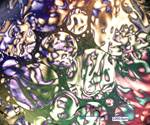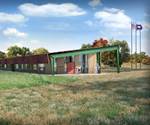University of Kentucky receives grant to turn coal pitch into carbon fiber
University researchers will work with industry partners to convert coal tar into carbon fiber for use in high-performance composite applications.

Source | University of Kentucky
The University of Kentucky Center for Applied Energy Research (CAER; Lexington, Ky., U.S.) has received a U.S. Department of Energy (DOE) grant supporting its efforts to transform coal tar pitch into carbon fiber for use in aircraft, automobiles, sporting goods and other high-performance materials. The $1.8 million project includes DOE funding and industry and university cost-share.
CAER researchers and partners will be converting coal tar — a byproduct from coke production for the steel industry — into mesophase pitch, a liquid crystal, which can then be spun and thermally converted to carbon fiber. If successful, the University of Kentucky claims this new carbon fiber product could increase the value of coal tar pitch by five to 55 times its current value, and be used in high-stiffness, low-weight composite applications such as passenger cars and light duty trucks.
The grant will support development of simplified, multi-filament melt spinning of the produced mesophase pitch into “green” (not yet carbonized) fibers, followed by continuous thermal processing, or oxidization, of those green fibers. The CAER team will then create woven preforms from the fibers for composites manufacture, as well as chopped carbon fiber for filled thermoplastics suitable for injection molding.
As part of the project, CAER researchers will be working with industry partners Koppers Inc. (Pittsburgh, Pa., U.S.) and Materials Sciences LLC (Horsham, Pa., U.S.).
“Being able to efficiently upgrade a coal byproduct into high-value carbon fiber for composites would be a terrific benefit to Kentucky’s and the nation’s manufacturers,” says Matt Weisenberger, associate director for materials technologies at CAER and principal investigator on the award. “It would add significantly to the coal value chain, further establishing Kentucky as a global leader in carbon fiber research and development.”
“We are excited to be at the forefront of developing coal as a valued precursor for products,” says Rodney Andrews, CAER director.
The University of Kentucky says its Center for Applied Energy Research is home to the largest carbon fiber spinline facility in a North American academic institution, and its carbon fiber research, development and innovation includes vehicle lightweighting projects such as hollow carbon fiber development for pressure vessels for on-board hydrogen storage.
Read more about other projects focused on developing carbon fiber from coal.
Related Content
-
Plant tour: Albany Engineered Composites, Rochester, N.H., U.S.
Efficient, high-quality, well-controlled composites manufacturing at volume is the mantra for this 3D weaving specialist.
-
Braskem demonstrates PP solutions using Weav3D composite lattice technology
Partnership combines Braskem’s polypropylene sheets with Weav3D Rebar for Plastics technology to address new structural, automotive applications requiring high-strength, lightweight material solutions.
-
Composite resins price change report
CW’s running summary of resin price change announcements from major material suppliers that serve the composites manufacturing industry.

.jpg;width=70;height=70;mode=crop)














